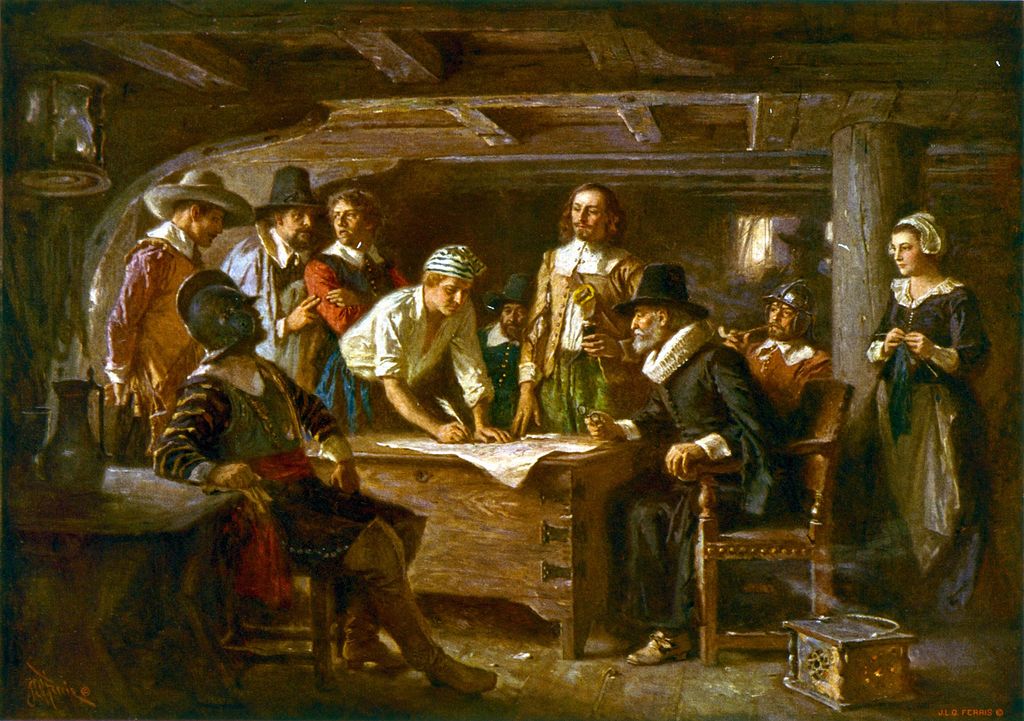In our reflections on the story of the pilgrims and the first Thanksgiving, we encounter a range of emphases across religious, cultural, and political divides.
For some, it’s a tale that points us to the power and importance of religious and political liberty. For others, it offers a compelling argument for boldly taking in the immigrant and the refugee—the persecuted, the impoverished, and afflicted. For others still, it represents a repudiation of socialistic theories and a demonstration of the glories of economic freedom and property rights, orienting our gratitude and sacrifice beyond human designs.
And rightly so!
The story of the pilgrims, simple though it may appear, is a unique case study in human history, offering a compact but comprehensive view into the multiple aspects of the liberty and conditions that are needed to establish and maintain a free and virtuous society.
“The Pilgrims were the first people to not merely verbalize but actually realize, to demonstrate over a span of decades, in their own lives as individuals and as a whole community, the unique American identity as an exceptionally free, orderly, and essentially devout people,” writes Charles H. Wolfe, president of the Plymouth Rock Foundation.
While Jamestown continued to struggle, the Pilgrim experiment took a different sequence altogether. From 1600 to 1636 and beyond, Wolfe explains, we see the pilgrims move from a pursuit of spiritual liberty to, decades later, constitutional liberty—moving between five distinct aspects of freedom. “They had to live out step by step the various aspects of the principle of Christian self-government that allowed them to experience, in an orderly, logical sequence the basic constituents of a comprehensive, genuine human freedom,” Wolfe explains.
To demonstrate Wolfe’s argument, I’ve provided key excerpts from each of the five stages he mentions. Each holds significant lessons for our current context, whether in illuminating all that we take for granted or in highlighting what we might be missing. (You can read the full essay here.)
1. Spiritual Liberty (1600)
Encouraged and inspired by the gifted Reformed pastors Richard Clyfton and John Robinson, to get and read their own Bibles (then against the law of England) and to receive Jesus Christ as personal Lord and Saviour (then no part of the teaching of the Church of England), the Pilgrims experienced a considerable degree of spiritual liberty (a measure of freedom from bondage to sin) and thus learned how to practice Christian self-government.
2. Religious Liberty (1603-1607)
Soon they were arrested by the Church police for worshipping apart from the Church of England. Apprehended and jailed, tried and found guilty, and finally released, they saw it was no longer feasible for them to live in their beloved England. With great difficulty (still pursued by the police, who insisted they stay in England) they escaped to Holland, where they found plenty of freedom.
But it was freedom to do your own thing, freedom run wild, and after a decade they found this materialistic, anti-Christian freedom was corrupting their children, and they decided they had to make a fresh start in the New World.
3. Political Liberty (1620)
While still aboard the Mayflower, anchored in Provincetown harbor, before they ever went ashore, the Pilgrims took their Biblical type covenant which they had framed for their church self-government in England and transmuted it into the Mayflower Compact, the world’s first written charter for local civil self-government. It was “democracy” with a spiritual undergirding, acknowledging the sovereignty of God and the primacy of His laws. As political scientists Willmoore Kendall and George Carey observe, the colony is being planted first, for “the glory of God,” second for “the Advancement of the Christian faith,” third for “the honor of King and country,” and fourth, “for our better ordering,” — that is, not just to form a free society, but an orderly, just and good society.
4. Economic Liberty (1623)
The first year under communal agriculture, the Pilgrims planted just 26 acres and nearly starved to death. As Governor Bradford reported, “they gathered in the small harvest that they had.” They shared what they could with the Indians, and the Indians shared the deer they had slain for the occasion with the Pilgrims, but it was no huge Thanksgiving feast, and they soon were acutely hungry. The second year, knowing they had to go all out, but still under the obligation to practice communal agriculture, they doubled their first year’s production, and planted 60 acres. But that was no by means enough, they still were near starvation.
And so the third year, they switched to private agriculture, assigned each family its own property, made each responsible for itself. They planted 184 acres, tripled their best previous effort, and never went hungry again. William Bradford wrote: “Thus out of small beginnings greater things have been produced by His hand that made all things of nothing, and gives being to all things that are; and as one small candle may light a thousand, so the light here kindled hath shone unto many, yea in some sort to our whole nation; let the glorious name of Jehovah have all the praise.”
5. Constitutional Liberty (1636)
The Mayflower Compact was an inspired document, but not a specific constitution, defining the form of their government, its functions and basic laws. Thus in 1636, not working only from theory, no matter how sound, but drawing also on some fifteen years of experience in self-government in the new world, the Pilgrims held a kind of mini-constitutional convention, which framed the Laws of the Pilgrims, also known as The Laws of Plymouth, a basic constitution that was revised from time to time but never abandoned.
The preamble to the 1671 version, introduced “with grace and peace in our Lord Jesus Christ,” began: “It was the great privilege of Israel of old, and so acknowledged by them (Nehemiah 9:13) that God gave them right judgments and true laws, which are so far good and wholesome as by how much they are derived from and agreeable to, the ancient platform of God’s law.”
Together, each of these stages didn’t just pave the way for success in the lives of the pilgrims. They paved the way for the future of American republicanism and democracy—both culturally and politically—sowing the seeds of principles that would later be enshrined in the Declaration of Independence and the United States Constitution.
As we give thanks around our tables, reflecting on the story of the pilgrims, we have the pleasure of nodding “yes” and saying “amen” to the host of themes that are sure to emerge across perspectives and personal priorities. We can express gratitude for a heritage not of narrow special interests, but of full-dimensional freedom.
Image: Signing the Mayflower Compact 1620, a painting by Jean Leon Gerome Ferris 1899

